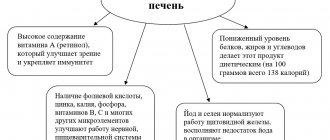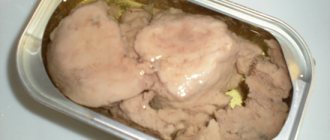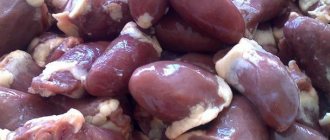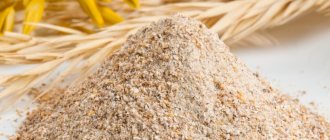Benefit
The liver is the most useful and valuable part of lamb. Due to the high concentration of protein in its composition, it ensures proper functioning of the body. However, the degree of fat content of meat affects the amount of protein in the offal.
It is this offal that is the main source of vitamins, for this reason it is even used for medicinal purposes. It is also low in calories, which is extremely important for people on a diet. At the same time, regular consumption of liver has a beneficial effect on the general condition of the body.
Interesting! Lamb liver prevails over meat in the amount of vitamins and is not inferior to it in nutritional value.
The special substance heparin, which is contained in the product, normalizes blood clotting and reduces the risk of heart attack.
Important! Lamb liver is a complete food product that is highly valued due to its high content of nutrients. The method of heat treatment determines whether the benefits of its use will remain.
Calorie content Duck liver. Chemical composition and nutritional value.
Nutritional value and chemical composition of “Duck Liver”.
The table shows the nutritional content (calories, proteins, fats, carbohydrates, vitamins and minerals) per 100 grams of edible portion.
| Nutrient | Quantity | Norm** | % of the norm in 100 g | % of the norm in 100 kcal | 100% normal |
| Calorie content | 136 kcal | 1684 kcal | 8.1% | 6% | 1238 g |
| Squirrels | 18.74 g | 76 g | 24.7% | 18.2% | 406 g |
| Fats | 4.64 g | 56 g | 8.3% | 6.1% | 1207 g |
| Carbohydrates | 3.53 g | 219 g | 1.6% | 1.2% | 6204 g |
| Water | 71.78 g | 2273 g | 3.2% | 2.4% | 3167 g |
| Ash | 1.32 g | ~ | |||
| Vitamins | |||||
| Vitamin A, RE | 11984 mcg | 900 mcg | 1331.6% | 979.1% | 8 g |
| Retinol | 11.984 mg | ~ | |||
| Vitamin B1, thiamine | 0.562 mg | 1.5 mg | 37.5% | 27.6% | 267 g |
| Vitamin B2, riboflavin | 0.892 mg | 1.8 mg | 49.6% | 36.5% | 202 g |
| Vitamin B5, pantothenic | 6.184 mg | 5 mg | 123.7% | 91% | 81 g |
| Vitamin B6, pyridoxine | 0.76 mg | 2 mg | 38% | 27.9% | 263 g |
| Vitamin B9, folates | 738 mcg | 400 mcg | 184.5% | 135.7% | 54 g |
| Vitamin B12, cobalamin | 54 mcg | 3 mcg | 1800% | 1323.5% | 6 g |
| Vitamin C, ascorbic acid | 4.5 mg | 90 mg | 5% | 3.7% | 2000 g |
| Vitamin RR, NE | 6.5 mg | 20 mg | 32.5% | 23.9% | 308 g |
| Macronutrients | |||||
| Potassium, K | 230 mg | 2500 mg | 9.2% | 6.8% | 1087 g |
| Calcium, Ca | 11 mg | 1000 mg | 1.1% | 0.8% | 9091 g |
| Magnesium, Mg | 24 mg | 400 mg | 6% | 4.4% | 1667 g |
| Sodium, Na | 140 mg | 1300 mg | 10.8% | 7.9% | 929 g |
| Sera, S | 187.4 mg | 1000 mg | 18.7% | 13.8% | 534 g |
| Phosphorus, Ph | 269 mg | 800 mg | 33.6% | 24.7% | 297 g |
| Microelements | |||||
| Iron, Fe | 30.53 mg | 18 mg | 169.6% | 124.7% | 59 g |
| Manganese, Mn | 0.258 mg | 2 mg | 12.9% | 9.5% | 775 g |
| Copper, Cu | 5962 mcg | 1000 mcg | 596.2% | 438.4% | 17 g |
| Selenium, Se | 67 mcg | 55 mcg | 121.8% | 89.6% | 82 g |
| Zinc, Zn | 3.07 mg | 12 mg | 25.6% | 18.8% | 391 g |
| Essential amino acids | |||||
| Arginine* | 1.148 g | ~ | |||
| Valin | 1.181 g | ~ | |||
| Histidine* | 0.498 g | ~ | |||
| Isoleucine | 0.995 g | ~ | |||
| Leucine | 1.691 g | ~ | |||
| Lysine | 1.418 g | ~ | |||
| Methionine | 0.444 g | ~ | |||
| Threonine | 0.833 g | ~ | |||
| Tryptophan | 0.264 g | ~ | |||
| Phenylalanine | 0.932 g | ~ | |||
| Nonessential amino acids | |||||
| Alanin | 1.088 g | ~ | |||
| Aspartic acid | 1.781 g | ~ | |||
| Glycine | 1.088 g | ~ | |||
| Glutamic acid | 2.428 g | ~ | |||
| Proline | 0.929 g | ~ | |||
| Serin | 0.806 g | ~ | |||
| Tyrosine | 0.66 g | ~ | |||
| Cysteine | 0.252 g | ~ | |||
| Sterols (sterols) | |||||
| Cholesterol | 515 mg | max 300 mg | |||
| Saturated fatty acids | |||||
| Saturated fatty acids | 1.44 g | max 18.7 g | |||
| 14:0 Miristinovaya | 0.01 g | ~ | |||
| 16:0 Palmitinaya | 0.8 g | ~ | |||
| 18:0 Stearic | 0.63 g | ~ | |||
| Monounsaturated fatty acids | 0.71 g | min 16.8 g | 4.2% | 3.1% | |
| 16:1 Palmitoleic | 0.05 g | ~ | |||
| 18:1 Oleic (omega-9) | 0.65 g | ~ | |||
| Polyunsaturated fatty acids | 0.63 g | from 11.2 to 20.6 g | 5.6% | 4.1% | |
| 18:2 Linolevaya | 0.37 g | ~ | |||
| 20:4 Arachidonic | 0.26 g | ~ | |||
| Omega-6 fatty acids | 0.63 g | from 4.7 to 16.8 g | 13.4% | 9.9% |
The energy value of duck liver is 136 kcal.
- unit (yield from 1 lb ready-to-cook duck) = 10 g (13.6 kcal)
- liver = 44 g (59.8 kcal)
Primary source: USDA National Nutrient Database for Standard Reference. Read more.
** This table shows the average levels of vitamins and minerals for an adult. If you want to know the norms taking into account your gender, age and other factors, then use the “My Healthy Diet” application.
How to choose
Due to the high water content in this by-product, it is a perishable product. To choose a fresh product, you need to pay attention to its appearance. There must be a thin film on the liver, and the surface must be slightly damp.
A high-quality product when cut has a brownish-red color, elastic and dense to the touch. After pressing, the dimple under the finger should quickly level out.
Curious! Its color determines how tender the product will be after heat treatment. It is better to give preference to lighter shades of the product.
Frozen offal should be avoided, since in this case it is impossible to determine its quality. Therefore, it is recommended to choose fresh or chilled liver.
Application
Lamb liver consists almost entirely of water, and therefore spoils quite quickly. Do not delay cooking purchased lamb liver, or it will lose all its beneficial properties. Before any cooking method, it is recommended to remove the film from the liver and remove the bile ducts; this will give the finished liver a more delicate structure. After processing, lamb liver can be fried in oil or simmered over low heat. Serve with any side dish. Mushroom sauce goes great with lamb liver.
Market Analytics
- COVID-19 is changing the rules of the game in the cosmetics market
- Beauty of the future: cosmetic innovations 2020
- New ingredients are the driving force of the cosmetics industry
Convenient search for beauty salons on our website
Beauty salons in Moscow Beauty salons in St. Petersburg Beauty salons in Ekaterinburg Beauty salons in Novosibirsk
Latest blog posts on our website
- Naturecream / Geranium (Pelargonium) oil for skin health and beauty
- Prostye-sovety / Save on a beauty salon: procedures that can be done at home
- Naturecream / Growth Factor - brings back youth?
- Oksana-Lezina / 3 effective abdominal exercises from a fitness instructor for beginners
- Prostye-sovety / Making perfect curls at home
- Prostye-sovety / Which hair removal method to choose
- Naturecream / Wrinkles Puppets
- Naturecream / PEPHA-TIGHT - instant skin lifting
- Naturecream / Blue light - a danger to the skin
- Naturecream / Cocoa Butter – A treat for the skin
Latest forum topics on our website
- Mrs._Smith / Badly sunburned! What to do?((
- Ice / Is it necessary to combine fitness classes with a diet?
- Antonova / What can be used for hair loss?
- Radio operatorKat / Who was on a protein diet?
- Suzanna / Mesotherapy on the face
Other articles in this section
| Suckling pig A suckling pig is a baby pig, fed with mother's milk, up to 2 months old. Dairy piglets feed exclusively on milk and are not given any other food. The weight of suckling piglets ranges from one to five kilograms. The meat of these animals is particularly tender and juicy. This is a dietary product, as its fat content is quite low. There is practically no fat layer in a pig, the meat is low in calories, has a light pink tint, and does not have a pronounced odor. |
| Fried chicken liver Fried chicken liver is one of the common delicacies and one of the most expensive parts of chicken. At the same time, many popular dishes are made from it in various countries. Cuisines of all nations of the world use this offal in their recipes. Fried chicken liver is devoid of astringency and bitterness, unlike the liver of other animals, such as pork. In some countries, fried chicken liver is a remedy for overwork and stress. In Korea, it is very popular among doctors. Nutritionists emphasize the importance of including chicken liver in the diet, but one should take into account the fact that the liver of any animal always processes radioactive and harmful substances, so it is recommended to consume it no more than once a week. |
| Veal shoulder Veal shoulder is pink-colored flesh with layers of fat. It has universal application in cooking. Connoisseurs of veal meat are Britain, Germany, the USA, and Great Britain. In these countries, they have not only invented many recipes for this dish, but are also actively involved in the production of this meat. In European countries, there are entire farms where calves are raised for slaughter. This meat is considered high quality due to the grain feed that is given to the animals. This type of veal is distinguished by its red color and pungent odor. |
| Lamb heart Lamb heart is practically not inferior to meat in terms of useful qualities and taste characteristics, and belongs to the by-product of the first category. A fresh heart has a rich red color with a slightly brown tint and, when pressed, quickly returns to its previous shape (due to the fine-fiber tissue with a very dense structure). |
| Roasted Venison In the Middle Ages, venison was the food of aristocrats; Now it is a daily diet for residents of the Far North, and for Russians it is a delicacy. |
| Boiled horse meat Horse meat is the meat of horses 2-3 years old. But the most delicious meat is considered to be the meat of a foal that is not yet a year old. This product was mainly consumed by nomads. Horse meat was previously the most easily obtained product, and horse meat dishes became traditional and favorite for nomadic people. And now this meat is popular in some countries of Central Asia and is considered a delicacy. Horse meat has an unusual taste and smell, but many people eat it because it is low in calories. To make the meat softer, horse meat must first be cooked for a couple of hours. |
| Pork kidneys Pork kidneys are an offal that resembles the shape of beans. High-quality pork kidneys are brown or light brown in color, have a smooth surface, and should not be torn or damaged. Kidneys are rich in many valuable substances necessary for the human body. |
| Smoked chicken As everyone knows, chicken meat is considered a dietary product. This is especially true for boiled and smoked cooking methods. People have been smoking this bird since ancient times, and every smoked dish turns out very tasty and juicy. There are two types of smoking: hot and cold. The former is much faster and the product is softer. The second method is longer - it requires several days. |
| Beef brisket Since mammoths became extinct and man learned to domesticate animals, people began to breed cattle for their own needs. According to legend, the cow was the first to come to human habitation and stayed forever. Cow's milk is the first product that can replace mother's milk. And beef has always been and remains a priority over other types of meat. Today, throughout the world, millions of different breeds have been bred and raised for food. Methods for raising and fattening calves differ from each other. Some breeds are suitable for slaughter as early as 10 months, others raise calves up to a year, and sometimes up to two years. Regardless of this, beef does not lose its value and taste. |
| Roast beef Roast beef is a classic dish originally from England, suitable for any table and occasion. Based on the name, the dish is very simple - a fried piece of beef. What could be simpler and tastier than a fragrant, substantial portion of cooked meat? |
Foie gras for a true gourmet is akin to the music of Bach for a music lover: exquisite classics with a rich history and varied interpretations. Along with truffles and black caviar, foie gras (French for “fat liver”) is one of the iconic delicacies of all times.
Not only regulars of fashionable restaurants know that foie gras is the liver of birds fattened in a special way. But not everyone knows that the name foie gras, according to French traditions, can only be carried by the liver of an ordinary goose and two types of ducks: musky and mullard ducks, and only males. Also, not everyone knows that these days 90% of foie gras is made from duck liver and only 10% from goose liver.
Over the centuries-old history of this delicacy, foie gras has been made from chicken, turkey, and even pork liver. However, taste and tradition took their toll.
It all started with wild geese, which were found in abundance on the banks of the Nile. Before the long flight home, the birds ate and accumulated fat not only under the skin, but also in the liver, causing it to increase in size and acquire a delicate, rich taste. This taste became known to the ancient Egyptians 4 thousand years ago and it is not surprising that it was in Ancient Egypt that they first began to specifically feed birds to obtain delicious liver: this is evidenced by images on a fresco dating back to 2500 BC, where a slave feeds a goose with figs (figs). ).
After the Egyptians, the Jews were in possession of the secret of increasing bird liver for a long time; in the 1st century AD, the Roman patricians feasted on the liver of geese fed with figs, so the prototype of foie gras reached France, where the delicacy acquired its current name (they say that the French word foie - “liver” " - has roots in the Latin word ficatum - “with figs”). In the 17th-18th centuries, specially fed ducks and geese were in the diet of not only high society, but also peasants - storing cooked foods in fat made it possible to make supplies for a long time.
The modern history of foie gras dates back to 1778, when the Marquis de Contade, Marshal of France and ruler of Strasbourg, told his young chef Jean-Pierre Clause the legendary phrase: “Today I want to treat my guests to real French cuisine.” And the young man came up with his own recipe: he cooked the liver in lard and stuffed the dough with it. The dish was a resounding success and soon found its way onto the table of Louis XVI, who presented the cook with 20 pistols as a token of gratitude. Jean-Pierre Clause himself began to actively popularize his invention, so the fame of foie gras gradually spread throughout the world.
With the invention of canning, the production of foie gras has reached a large scale and these days you can taste the great delicacy not only in the homeland of haute cuisine. In Moscow alone, about a ton of foie gras is consumed monthly. You can even buy raw foie gras in vacuum packaging or ready-to-eat canned foie gras in a good supermarket and cook it yourself. France remains the leader in the production of foie gras, which recently included this product as a cultural heritage of the country. Hungary occupies second place in the list of producers, and Belgium takes third place. The first Russian farm where foie gras is produced from the liver of mulard ducks appeared recently near St. Petersburg: it was founded by the owners of the Le Paris restaurant.








